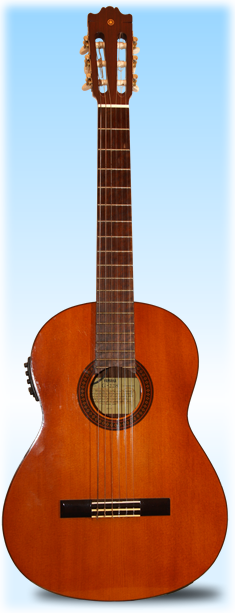
Yamaha G-228 Classical Guitar The Yamaha G-228 Classical Guitar is a solidly made and lovely sounding 6 string classical style guitar. Perhaps better than a beginner's guitar, but certainly not pro quality.
|
GEAR RELATED ARTICLES
[Home Music Recording Studio]
GUITAR AMPLIFIERS:
Acoustic 450 - 170W Guitar / Bass Amp Head
Behringer Ultrabass BXL1800A 180W Bass Amp
Fender Princeton Chorus 51W Compact Amp
GUITARS:
Aspen AD25 6 String Acoustic Guitar
Esteve Model 8 Classical Guitar
La Patrie Concert CW QIT Classical Guitar
La Patrie Presentation Classical Guitar
Fender DG-14SCE Nat Acoustic Guitar
Godin XtSA Electric Guitar
Godin Freeway Classic Electric Guitar
Ibanez RG8 8 String Electric Guitar
Jim Beam Devil's Cut 335 clone
Maton EM125C - 6 String Acoustic Guitar
Maton EM425C/12 12 String Acoustic Guitar
Maton Mastersound MS500 - 6 Str Electric Guitar
Yamaha FG-410-12A 12 String Acoustic
Yamaha G-228 6 String Classical
GUITAR FX - The Chronicles of Zoom:
ZOOM GFX-707 - Review and Description
ZOOM 707 II - Review and Description
ZOOM BFX-708 - Bass Guitar Multi Effects Pedal
ZOOM G9.2tt - Guitar Effects Console
Behringer EM600 Echo Machine Stomp Box
Behringer RV600 Reverb Machine Stomp Box
ROLAND U-220 - Vintage Sound / Synth Module
SN-U110 and SN-MV30-S1 Series PCM Cards
Behringer FBQ1502HD Ultragraph Pro
Behringer Eurorack Pro RX1602 Rackmount Mixer
Capabilities of the CASIO WK-7500 Workstation
Presonus Eris E5 Powered Monitor Speakers
Vonyx (Skytec) SPJ-1000A Active 10" Speaker
[ Advertising ]
The Yamaha G-228 Classical Guitar was an entry level instrument or student guitar, made by Yamaha in Taiwan between 1983 and 1985. The G-228 is a very well made guitar. Compared to some similar items currently available from China the build quality would probably be considered excellent to exceptional. However, in it's day the G-228 was a relative cheapie.
Modeled on Spanish classical instrument designs, there are no active/piezo elements and no cut-away either. Being a classical guitar, it is slightly deeper than a flamenco guitar, which is reflected in the pleasing depth of tone this guitar can produce.
While looking for a serviceable classical style instrument, I purchased a Yamaha G-228 sometime around mid 1987 (or
about
years ago).
My criteria were quite simple: Sound quality, playability and price. The G-228 Classical Guitar was on sale at the time, so I was essentially on a winner. As I remember, the guitar case cost me more than the guitar and both proved to be an excellent choice.
Of course, I've been looking to upgrade for a while now - you know, since about 1990. But the fact is, I only play a handful of pieces specifically suited to classical guitar and the Yamaha G-228 has done the job well.
Update: In 2020 I finally upgraded to a far superior instrument. A La Patrie Concert CW by Godin - and, at nearly 10 times the price, sadly there is no meaningful comparison between the two instruments ... except, that the piezo pickup/preamp/EQ/Tuner that I installed into the G-228 seems better than the Godin unit that comes with the La Patrie as standard ... who would have guessed?
![]()
 About Review and Description articles, click to expand
About Review and Description articles, click to expand
Note:
The Yamaha G-228 Classical Guitar can still be seen listing online for around USD $75 in good condition (without a case). In Australia, expect to pay anywhere up to AUD $250 (plus shipping) for one in good condition. Beware of low list prices and outrageous shipping charges ... and try to get one with a case or at least a decent bag. These instruments are susceptible to environmental change, particularly humidity.
Playing the Yamaha G-228 Classical Guitar
I tend to joke that playing a classical guitar is like playing on rubber bands. Since I also have multiple steel string acoustics, electrics and basses, the nylon strings tend to always feel a little floppy when I haven't picked up this guitar for a while. I takes a moment of mental gymnastics to settle back in to that classical groove and not overplay notes.
But as far as it goes, the Yamaha G-228 plays well enough. Being a broad, flat necked, classical design there is no meaningful adjustment for the action. That is, other than to shave down the bridge piece and/or deepen the string slots in the nut.
And of course, if you go to far, you will end up with string buzz - well, let's just say that if you get it wrong, you will be making a lot of work for yourself to no good end.
Perhaps also worth noting is that I do tend to use the high-tension nylon strings. These do give a little extra sparkle - at least while the strings are still reasonably new.
I have included measurements with the Yamaha G-228 specifications below.
Yamaha G-228 Sound
Acoustically, the Yamaha G-228 Classical Guitar has a very good depth of tone and a generally balanced overall sound. Which, not surprisingly, is largely why I bought it. Since I purchased this guitar new, I can confidently say it has always sounded quite good.
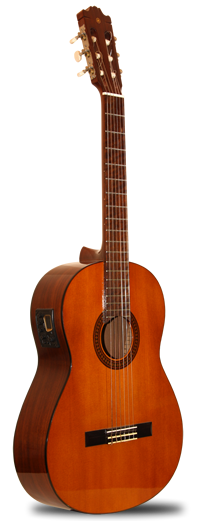 Once again, ageing timbers (now
old) are probably adding an element of richness and warmth to the Yamaha G-228's sound.
Once again, ageing timbers (now
old) are probably adding an element of richness and warmth to the Yamaha G-228's sound.
The Yamaha G-228 Classical Guitar records 'alright' when mic'd up, but don't get the mics too close or the sound will get quite muddy.
You will almost certainly be spending some time EQ'ing the bottom end (cutting around 250Hz) and messing around with mic positions. Off-axis either side of the sound hole tends to work better than pointing straight at the sound hole.
If there is feedback in live/amplified playing situations, applying some chorus may help to fix that - or put a baffle in the sound hole.
I have installed a piezo system (as seen in the photos), greatly simplifies recording and live playing - Highly recommended!
Build Quality / Workmanship / Reliability
The Yamaha G-228 classical guitar is a well made standard sized instrument, showing no major adverse signs of ageing, even after
years ![]() . This is a true classical design, complete with Spanish heel and no truss rod. The rosette is real, not a decal.
. This is a true classical design, complete with Spanish heel and no truss rod. The rosette is real, not a decal.
The top is laminated spruce while the back and sides are laminated mahogany. The original nut and saddle are white plastic (not bone, as I have read elsewhere).
The tuning pegs are functional but really ordinary and cheaply made. If you like all the other aspects of this guitar the tuning pegs are certainly worth upgrading.
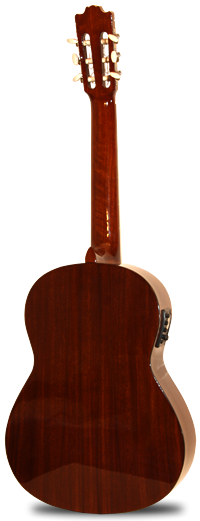
The internal bracing is relatively light and while there has never been evidence of neck twisting or bending, unwanted bulges in the body (at the bridge) can be an issue with this guitar. Particularly in high humidity situations.
You will generally notice when this happens, as the action goes from the normal classical 'crappy' to 'WTF is happening here! - Why are the strings so high?' On the plus side, the fix is simple enough. Remove all tension for a few months and allow the top to settle back into its appropriate position - and then, keep it the hell away from moisture!
Quite obviously, the bracing could have been better. At a guess I would say that rigidity has been sacrificed for improved tonality.
The workmanship and attention to detail is generally excellent for an instrument produced in Taiwan. Generally surpassing the quality of similar price-point instruments made today.
The Yamaha G-228 that I have, has spent much of its life inside a guitar case, when not in use. Though (since 2008) for a over decade or so, it was out constantly on a stand of one type or another. Thankfully with no further attendant problems. I did generally play this guitar at least several times per week.
Remember that saying: 'out of sight, out of mind'. Well that's why I keep all my guitars visible. That way, they all get played (and restrung at useful intervals ;-)
Strings for the Yamaha G-228
As mentioned earlier, I do tend to use high-tension nylon strings. These strings give a little extra sparkle to a classical guitar sound that, in this case, already has plenty of depth.
Originally (for nearly 3 decades), I used high-tension Savarez strings (Red Card 520 R). I have to say, these sounded very good (apart from occasional string squeak, due to their unpolished finish). The real problem was, that whenever I wanted to play, it seems a lot of the time I would almost instantly break a string. I'd even heard strings letting go with a dull 'twunk!' while the G-228 was still inside the case - you know, just minding its own business ;-)
So these days I use high-tension Martin nylon strings (M120 Silver Plated) - and - when not in use, tune them down one semitone or even a full tone (just in case).
Now I get to choose when I replace strings - and also, it doesn't cost me over $25 a throw! One can get the Martin classical strings at around half to two thirds the price of the Savarez sets - subject to availability of course.
The Martin strings work just fine, bringing out the richness of tone that the Yamaha G-228 can produce, yet with an elegant sufficiency of brightness (sorry, couldn't help myself ;-)
I would probably change the strings as a matter of course, a minimum of twice a year - and/or a few days prior to doing any recording. The upside of replacing strings before they break, is that you will generally always have a few old spares (for when a string does happen to let go at some truly inconvenient moment).
Notes:
Also if you are new to nylon string / classical guitars - detune your guitar (a tone or two) over the warmer summer months when not playing it. Then tune up to full tension only when needed. The nylon strings will sound and play better for longer, if they don't lose their elasticity.
When trying new strings, first buy a single pack (or two for spares) to see if they work for you. Once you find some that you like, try to buy them in three pack bundles - it's usually a good 20% cheaper that way.
String specs:
Currently using
Martin Silver Plated Classical Guitar Strings 28-43 High Tension Plain End - M120 (or M160 ball end)
Gauges:28-32-40-30-35-43
Previously used
Savarez 520R Traditional Red Card High Tension Classical Guitar Strings - 520 R
Gauges:28-32-40-30-34-42
(these seemed to break frequently and are relatively, very expensive)
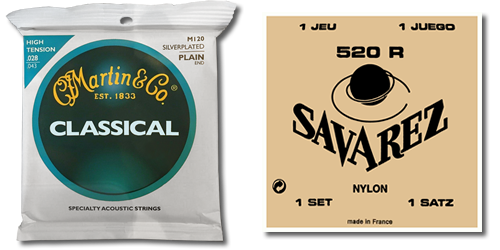
Value for Money
The Yamaha G-228 was just 'OK' value for money in it's day, back in the mid to late 80's. I purchased the G-228 partly because it was on sale and reduced by around 30%. The next option up, would have set me back over $100 more. The G-228 is just a nice classical guitar, not an excellent classical guitar and the original list price (USD $125) reflects that. These days expect to pay around AUD $125 to $250 (USD $75 to $150) for a used G-228 in good condition. However, try to get one with a case or bag - it's worth it.
This is not likely to ever become a collector's guitar - well, at least not in this universe. Watch out for sellers making claims about it being a
year old vintage guitar - which of course it is - it's vintage 1983 (or thereabouts) - which does not increase its intrinsic value in the slightest.![]()
Repairs, Parts, Restoration
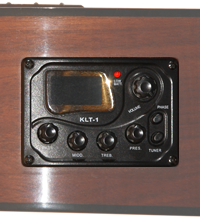 In a nutshell - This is not a solid top guitar that you would waste a lot of time and/or money on to restore. Perhaps with the exception of some new tuning pegs, should they have been knocked about and damaged. That should be a relatively easy and inexpensive fix (assumes that an appropriately sized replacement exists). If there is any serious luthier work - forget it.
In a nutshell - This is not a solid top guitar that you would waste a lot of time and/or money on to restore. Perhaps with the exception of some new tuning pegs, should they have been knocked about and damaged. That should be a relatively easy and inexpensive fix (assumes that an appropriately sized replacement exists). If there is any serious luthier work - forget it.
A mod I would recommend however, and have implemented, is a piezo pickup / EQ / tuner. Preferably one with a low impedance output option. The low impedance output lets you dump it into any available balanced mic input (e.g. mixer or DAW) if required. You can only increase the value of this guitar, if such a mod is done properly. If you are going to the trouble of a preamp, consider a bone nut & saddle while you are at it.
Just FYI: I tend to replace (as required) any plastic components on my guitars, like the nut and bridge piece (saddle), with bone ones which I shape as needed. The bone blanks can easily be sourced for a few dollars on ebay.
Replacing the plastic parts with bone ones does improve brightness, sustain and also means that you will never have to do it again in your lifetime. Just make sure that all bone edges that contact the strings are exceptionally smooth, or you will find that you frequently cut through, particularly the pure nylon strings.
Summary
At present my Yamaha G-228 Classical Guitar is still largely in original condition (plus piezo pickup/preamp as shown in photos), with no sign of needing any other work. When the preamp was installed, I took the opportunity to adjust the bridge piece height and fine tune the action. But that's about it.
So overall, a nice guitar to play. Has a good mellow tone, but needs new strings for true brightness (like when you are recording). Won't bust the bank if you can find a used one in good nick and of course - handy to have around (I think my X used say something like that about me ;-)
Beware of eBay Sellers ... Copying parts of this page, while claiming this guitar has a solid top - it does NOT!
There may have been versions briefly 'Made in Japan', but these guitars are still completely made from laminated timbers (that's Plywood). That won't change regardless of how well the seller has cut'n polished the finish on the guitar or the fact that it's 40 years old. If it makes you feel good paying 3 times what this guitar worth ... by all means go for it.
Additional Notes:
Determining the age of a Yamaha G-228 classical guitar
by decoding the serial number
The Yamaha G-228 classical guitar was in production at the
Kaohsiung Factory in Taiwan (the label states PRC) over an almost 4 year period between the start of 1982 and end of 1985. The serial number consists of 8 digits, where the first number is the year, the second and third numbers are the month and the fourth and fifth numbers are the day. The final three numbers are the unit production number. The serial number can be seen on the end of the neck when looking into the sound hole.
So the serial number 40214086 would read as: 1984 Feb 14 #086
Please Note: Yamaha have used many different instrument dating schemes over the years. I'm not an expert on Yamaha guitars, so if you are having difficulty please go here (or contact Yamaha):
https://mycoolguitars.com/mij/yamaha-guitars/yamaha-guitar-serial-numbers-dating-your-guitar/
Yamaha G-228 Specifications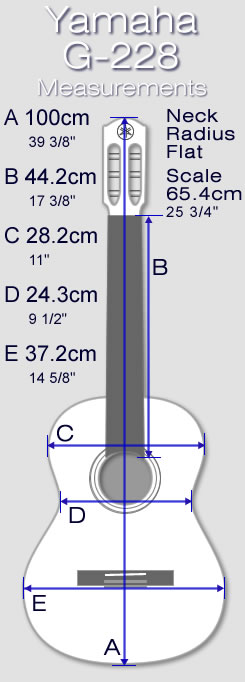
The Yamaha G-228 will snugly fit into a standard classical guitar case.
| Year(s) Sold: | 1982 - 1985 |
| Original MSRP* (US$): | $125.00 (AUD $200+) |
| Body Depth: | at C 95mm (3 3/4 ") at E 100mm (4") |
| Neck Width: | Nut 52mm (2 1/16") 19th Fret 66mm (2 9/16") |
| Neck Radius: | Flat |
| Scale: | 65.4cm (25 3/4") |
| Neck: | Nato |
| Fingerboard: | Ovangkol |
| Soundboard: | Spruce (laminated) |
| Rosette: | Timber Mosaic |
| Back &Sides: | Mahogany (laminated) |
| Outer Binding: | Black colour |
| Bridge: | Nato |
| Saddle & Nut: | White Plastic |
| Finish: | Gloss Clear |
| Pick Guard: | None |
| Machine Heads: | White Plastic Chromed / Brass |
Review Ratings:
- Playability - 7 / 10 (it's a standard design classical guitar after all)
- Sound - 7 / 10 Good, but not special
- Build Quality - 7 / 10 Score could have been higher, but is susceptible to humidity.
- Durability & Reliability - 8 / 10 Time proven
- Value for Money - 6 /10 A good little classical guitar, but these days you could do better.
- Overall Average Score ... 7 / 10
Your comments and contributions have been greatly appreciated!
Comments & Page Ratings Section Closed
| Final Page Ratings after 4 years | ||
| Excellent | 20 | |
| Very Good | 1 | |
| Useful | 0 | |
| Not Useful | 0 | |
| TOTAL | 21 | |
Page online for years
Your Comments:
230221 - (Excellent) - Merci beaucoup pour toutes ces précisions, je vais en acheter une aujourd'hui a 20€‚ en france.
(Thank you very much for all these details, I'm going to buy one today at 20€‚ in France.)
Editor's Note: Merveilleux, merci d'avoir écrit.(Wonderful, thankyou for writing.)
211208 - (Excellent) - What a great review. Nice to have a review of a guitar done by someone that had the guitar for such a long time and knows what he is talking about. Thank you very much.
Editor's Note: Thankyou! always nice to have one's efforts appreciated.
211014 - (N/R) - Hello friend, confused on the date /serial no. System. The label says G228 made in japan but the stamped serial no. Is 20402. Is this the #A2 system of 1986-90. Thought G228s were built 1982-85. Please help with date clarify.
Editor's Note: The G228 mentioned on this page is Made in Taiwan. Please go here: https://mycoolguitars.com/mij/yamaha-guitars/yamaha-guitar-serial-numbers-dating-your-guitar/ ... and if that doesn't help, you will just have to do some more research - like the rest of us!
210327 - (Excellent) - I was looking for info as I'm going to sell mine. The serial number dates it to Pre 1968 from what I have found on the internet. I am also from Port Stephens in NSW Australia & was amazed to see the previous comment also came from someone living in this same area. Lots of great info. Thanks
Editor's Note: Well, if it is really dated to pre 1968, then it is not a Yamaha G-228, which were made between 1982 and 1985 :-)
210326 - (Excellent) - Wonderful info, thanks. Now know I've got one made on January 23, 1984!
201225 - (Excellent) - I live in Port Stephens, NSW, Australia. I went to Vinnies and saw this guitar for $60 in perfect condition. When I paid, they charged me 30 bucks as it was all 50% off. How lucky am I ;-)
Editor's Note: Ah! G'day mate, nice ta hear from a fellow S'tralian. To get anything of that vintage in perfect condition is a very good score indeed! Just btw, I volunteer one day a week at a Vinnies in Tassie - recycling is good!! :-)
201119 - (Very Good) - Got one, the guitar was stored in the attic for decades and unfortunately the table has bent slightly due to the strings tension. Overall great sounding guitar but not that easy to play.
Editor's Note: Yep, the flat broad neck is actually tiresome after a while and the frets are quite narrow as well. Makes intonation easier, but speed somewhat more difficult and slides (glissando) near impossible.
That's why (in 2020) I finally bit the proverbial bullet and upgraded to a La Patrie Concert CW Q1T (about AUD $1,450 to $1,650 without case), which is a hybrid classical design with narrower curved fretboard, cutaway and bi-directional truss rod. Yummy!
Since then I also purchased a used and slightly damaged La Patrie Presentation (for around AUD $400), because it came with a Tric guitar case, which I wanted for the Concert CW. The Presentation will be repaired and is already sold again.
For those who might be interested, the Godin Presentation is much the same as the Godin Concert classical but with slightly lesser build quality (new for around AUD $1,250 without case). Both Godin classical guitars are made using solid timbers all round, have active electronics as options, sound great and are a joy to play. And for the money you're spending, that's just as well ;-)
201024 - (Excellent) - Thank you so much! - Greetings from Germany.
200917 - (Excellent) - Thanks, Just the information I was looking for.
Editor's Note: :-)
Incept Date: Wizard - 200417
Last Update: Wizard - 230301

